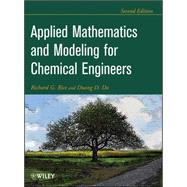
Note: Supplemental materials are not guaranteed with Rental or Used book purchases.
Purchase Benefits
What is included with this book?
RICHARD G. RICE, PhD, is Emeritus Professor at Louisiana State University and widely published in the areas of chemical separations and two-phase flow.
DUONG D. DO, PhD, is University Professor at the University of Queensland, Australia, and is well-known in the area of adsorption science.
Preface to the Second Edition xi
Part I. 1
1. Formulation of Physicochemical Problems 3
1.1 Introduction 3
1.2 Illustration of the Formulation Process (Cooling of Fluids) 3
1.3 Combining Rate and Equilibrium Concepts (Packed Bed Adsorber) 7
1.4 Boundary Conditions and Sign Conventions 8
1.5 Models with Many Variables: Vectors and Matrices 10
1.6 Matrix Definition 10
1.7 Types of Matrices 11
1.8 Matrix Algebra 12
1.9 Useful Row Operations 13
1.10 Direct Elimination Methods 14
1.11 Iterative Methods 18
1.12 Summary of the Model Building Process 19
1.13 Model Hierarchy and its Importance in Analysis 19
Problems 25
2. Solution Techniques for Models Yielding Ordinary Differential Equations 31
2.1 Geometric Basis and Functionality 31
2.2 Classification of ODE 32
2.3 First-Order Equations 32
2.4 Solution Methods for Second-Order Nonlinear Equations 37
2.5 Linear Equations of Higher Order 42
2.6 Coupled Simultaneous ODE 55
2.7 Eigenproblems 59
2.8 Coupled Linear Differential Equations 59
2.9 Summary of Solution Methods for ODE 60
Problems 60
References 73
3. Series Solution Methods and Special Functions 75
3.1 Introduction to Series Methods 75
3.2 Properties of Infinite Series 76
3.3 Method of Frobenius 77
3.4 Summary of the Frobenius Method 85
3.5 Special Functions 86
Problems 93
References 95
4. Integral Functions 97
4.1 Introduction 97
4.2 The Error Function 97
4.3 The Gamma and Beta Functions 98
4.4 The Elliptic Integrals 99
4.5 The Exponential and Trigonometric Integrals 101
Problems 102
References 104
5. Staged-Process Models: The Calculus of Finite Differences 105
5.1 Introduction 105
5.2 Solution Methods for Linear Finite Difference Equations 106
5.3 Particular Solution Methods 109
5.4 Nonlinear Equations (Riccati Equations) 111
Problems 112
References 115
6. Approximate Solution Methods for ODE: Perturbation Methods 117
6.1 Perturbation Methods 117
6.2 The Basic Concepts 120
6.3 The Method of Matched Asymptotic Expansion 122
6.4 Matched Asymptotic Expansions for Coupled Equations 125
Problems 128
References 136
Part II. 137
7. Numerical Solution Methods (Initial Value Problems) 139
7.1 Introduction 139
7.2 Type of Method 142
7.3 Stability 142
7.4 Stiffness 147
7.5 Interpolation and Quadrature 149
7.6 Explicit Integration Methods 150
7.7 Implicit Integration Methods 152
7.8 Predictor-Corrector Methods and Runge-Kutta Methods 152
7.9 Runge-Kutta Methods 153
7.10 Extrapolation 155
7.11 Step Size Control 155
7.12 Higher Order Integration Methods 156
Problems 156
References 159
8. Approximate Methods for Boundary Value Problems: Weighted Residuals 161
8.1 The Method of Weighted Residuals 161
8.2 Jacobi Polynomials 179
8.3 Lagrange Interpolation Polynomials 172
8.4 Orthogonal Collocation Method 172
8.5 Linear Boundary Value Problem: Dirichlet Boundary Condition 175
8.6 Linear Boundary Value Problem: Robin Boundary Condition 177
8.7 Nonlinear Boundary Value Problem: Dirichlet Boundary Condition 179
8.8 One-Point Collocation 181
8.9 Summary of Collocation Methods 182
8.10 Concluding Remarks 183
Problems 184
References 192
9. Introduction to Complex Variables and Laplace Transforms 193
9.1 Introduction 193
9.2 Elements of Complex Variables 193
9.3 Elementary Functions of Complex Variables 194
9.4 Multivalued Functions 195
9.5 Continuity Properties for Complex Variables: Analyticity 196
9.6 Integration: Cauchy’s Theorem 198
9.7 Cauchy’s Theory of Residues 201
9.8 Inversion of Laplace Transforms by Contour Integration 202
9.9 Laplace Transformations: Building Blocks 204
9.10 Practical Inversion Methods 209
9.11 Applications of Laplace Transforms for Solutions of ODE 211
9.12 Inversion Theory for Multivalued Functions: the Second Bromwich Path 215
9.13 Numerical Inversion Techniques 218
Problems 221
References 225
10. Solution Techniques for Models Producing PDEs 227
10.1 Introduction 227
10.2 Particular Solutions for PDES 231
10.3 Combination of Variables Method 233
10.4 Separation of Variables Method 238
10.5 Orthogonal Functions and Sturm-Liouville Conditions 241
10.6 Inhomogeneous Equations 245
10.7 Applications of Laplace Transforms for Solutions of PDES 248
Problems 254
References 271
11. Transform Methods for Linear PDEs 273
11.1 Introduction 273
11.2 Transforms in Finite Domain: Sturm-Liouville Transforms 273
11.3 Generalized Sturm-Liouville Integral Transforms 289
Problems 297
References 301
12. Approximate and Numerical Solution Methods for PDEs 303
12.1 Polynomial Approximation 303
12.2 Singular Perturbation 310
12.3 Finite Difference 315
12.4 Orthogonal Collocation for Solving PDEs 324
12.5 Orthogonal Collocation on Finite Elements 330
Problems 335
References 342
Appendix A. Review of Methods for Nonlinear Algebraic Equations 343
Appendix B. Derivation of the Fourier-Mellin Inversion Theorem 351
Appendix C. Table of Laplace Transforms 357
Appendix D. Numerical Integration 363
References 372
Appendix E. Nomenclature 373
Postface 377
Index 379
The New copy of this book will include any supplemental materials advertised. Please check the title of the book to determine if it should include any access cards, study guides, lab manuals, CDs, etc.
The Used, Rental and eBook copies of this book are not guaranteed to include any supplemental materials. Typically, only the book itself is included. This is true even if the title states it includes any access cards, study guides, lab manuals, CDs, etc.